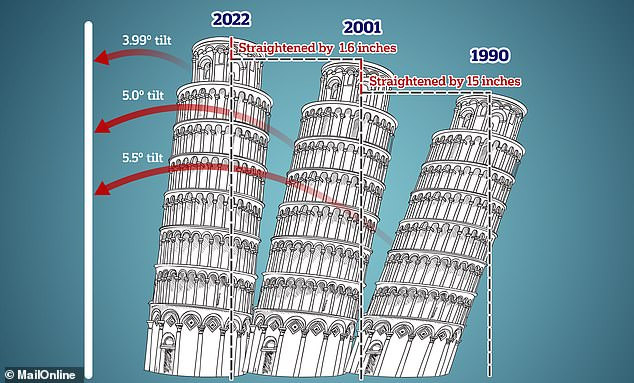The famous Leaning Tower of Pisa in Italy is visited every year by thousands of tourists who pose as if they are standing or leaning against the tower. While these photos are now classics, the tower’s slope has been a concern for engineers and historians for decades.
A recent study showed that this slanting bell tower in Italy started to straighten steadily thanks to stabilization work.
An 11-year stabilization project reduced the tower’s inclination by about 40 centimeters by 2001, and in the 21 years since then the tower has improved by another 4 centimeters.
The latest work was funded by the conservation organization Opera Primaziale della Pisana (OPA) to see if their predictions were correct.
A symbol of the power of the medieval maritime republic of Pisa, the medieval bell tower has survived unscathed by at least four severe earthquakes that have struck the area since 1280. A 2018 study found that the tower survived these severe jolts thanks to the softness of the foundation soil that caused its tilt.
Theories suggest that the 57-foot tower began to sink after construction began in 1173. This is due to an imperfect design, in which it is set on a foundation that is only three meters deep and placed on weak, unstable ground.

The soil under the foundation was softer on the south side, which caused the slope. Therefore, when building eight floors, an attempt was made to compensate for this slope by building floors on one side shorter than the other, causing it to bend at the same time as it bent.
Construction was not completed until 1319 due to the various wars between Pisa and Genoa, Lucca and Florence, but these pauses gave the tower more time to settle into the ground below.
By 1990, the tower was still leaning 5.5 degrees south and was closed to the public for fear of collapse.
After several different unsuccessful attempts to fix the structure, the engineers decided to try “soil extraction”. Two truckloads of earth were dug out from under the north side of the tower before using steel cables to pull the structure upright.
While this was effective, the team noticed that the building tilts more during rains in winter, as the water table below the north side is higher. Therefore, they also had to dig sewers so that water could flow into the wells and keep the foundation stable.
The project was completed in 2001 by flattening the tower by 38 cm, or 0.5°, and has been correcting itself ever since. According to ANSA, experts said at a health check in 2005 that it would be safe for the next 300 years.
Another check in 2013 showed that the famous Italian structure has flattened vertically by about 2.5 cm since 2001.
Another inspection was carried out by the OPA in 2018 to measure how much the tower has flattened since 2001, and it was found to have improved by 4 cm.